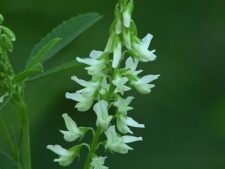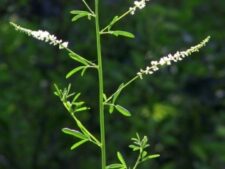
WHITE SWEET CLOVER
Melilotus alba
BEAN FAMILY (Fabaceae)
 Identification
Identification
- Flowering time - June, July, August, September, October
- Common along roadsides, in prairie restorations and other disturbed sites
- Long tapered clusters of tiny, white pea-like flowers
- Leaves divided into 3 slender oval leaflets
This naturalized annual or biennial was introduced from Eurasia. The stems are erect, branched and may reach 6 feet or more in height (C). The compound leaves have three oval-shaped leaflets, each about 1 inch long (A,C). The tiny, white pea-like flowers are crowded on long, tapered clusters (racemes) up to 8 inches long (B).
Common along roadsides, in fields, in our prairie restorations and other disturbed ground at both FF and NW. Flowering occurs from June through October.
White sweet clover was introduced from Eurasia for forage and as a nitrogen-enriching crop. It quickly escaped from cultivation spreading extensively into disturbed areas and was well established in Nebraska by the late 1800’s. It has been a problem “weed” in some of our prairie plantings.
This plant is similar vegetatively to Yellow Sweet Clover which begins to flower a bit earlier. Both plants contain coumarin, responsible for the sweet odor especially evident in the drying leaves. If the plant becomes moldy coumarin can convert to the anticoagulant dicoumarol which can cause bleeding in animals consuming the hay.
The content of NatureSearch is provided by dedicated volunteer Naturalists of Fontenelle Forest who strive to provide the most accurate information available. Contributors of the images retain their copyrights. The point of contact for this page is: Roland Barth.


